Menu

Agriculture is causing 18.4 percent of the world’s greenhouse gases. As 2024 approaches, the focus is on green farming. There’s a big push for farming that’s good for the planet and uses modern methods. To meet a demand that will be 68 percent higher in 2050, farmers need to be more innovative. The use of drones and devices that connect to the internet is very important, according to the USDA. Also, people all over are choosing food that’s grown in ways that don’t harm the Earth too much, which is great for everyone’s health.
Digital tools and smart farming are making a big difference. Companies like Phytech and Syngenta are working together. They help farms use resources better and produce more. Another big change is farming in cities and stacking plants on top of each other in fields, which uses less land. AeroFarms in New Jersey is a good example of this. Also, fake meats made in a lab, like what Beyond Meat does, are becoming more popular. For instance, Singapore has approved these fake meats, showing a change in how people and laws see them.
Global environmental rules keep improving, making it vital for those in farming to know the latest. These rules help tackle climate change and ensure there’s enough food. Lately, the focus is on lowering emissions in the food and farming sector, which greatly affects the planet. Let’s explore key changes and why they matter for farmers.
The world’s green rules for farming are getting a major update. Big agreements, like the Paris Agreement, and actions like Climate-Smart Agriculture are becoming the norm. Lately, we’ve seen many warnings about not doing enough to cut harmful emissions, such as carbon dioxide. This is seen as urgent based on reports by groups like the U.S. Global Change Research Program.
For those in farming, knowing and applying these global green rules is key. These rules can change how farms grow, use resources, and access markets. Studies by the World Meteorological Organization and the National Research Council highlight how crucial it is to follow these rules.
In the United States, the use of renewable energy went up 27% from 1990 to 2015. During this time, the CO2 each person produced dropped by 21%. Yet, countries like Brazil and India saw their CO2 emissions go up a lot.
Not long ago, more countries are agreeing to follow these rules, quicker than before. For example, key treaties like the Kyoto Protocol and the Paris Agreement gained a lot of support fast. This quick global agreement shows the growing urgency around environmental issues.
| Agreement | Member Countries | Time to 100 Ratifications |
|---|---|---|
| Montreal Protocol | 197 | 16 years |
| CITES | 183 | 16 years |
| Kyoto Protocol | 192 | 5 years |
| Paris Agreement | 195 | 1 year |
Following these green rules isn’t just about keeping up; it’s about being able to sell products globally. They set a standard for sustainable practices in farming. This helps with getting support and staying competitive in the world market.
With climate change challenges growing and the need to feed more people, CSA has become key. It focuses on farming that’s good for the planet, as traditional farming methods cause a lot of emissions. CSA looks at making farming sustainable by following environmental farming standards worldwide. These standards help meet the goals of farming sustainability legislation.
CSA works to fight hunger and deal with climate change at the same time. It aims to make farm plants better at handling the changing weather, use water smarter, and keep the ground healthy. Because farming adds to the gas that warms our planet and harms plants and animals, we need to change how we farm.
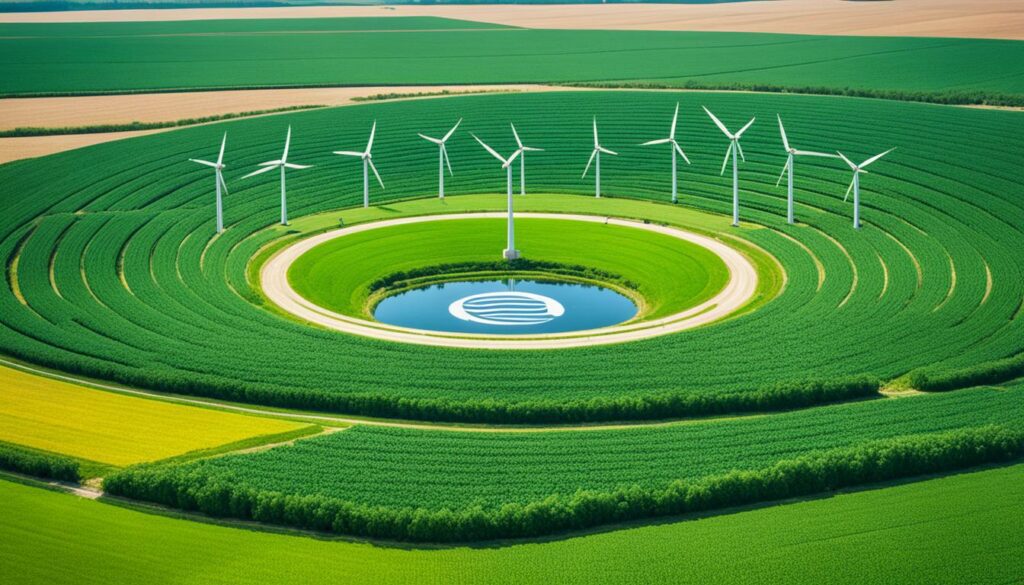
Here are some important things CSA does:
As more people need food, these practices are crucial. By 2050, we’ll need food for 9.7 billion people. Big organisations, like the World Bank, are investing in CSA to make farming more planet-friendly. They’re giving money for greener farming in China and Africa. These efforts show the importance of CSA for the future of farming.
The farming community gains a lot from using CSA methods:
Take the World Bank, for example, it now puts nearly $3 billion every year into CSA projects. Some money goes to places like Pakistan and Jordan to help farmers improve their ways. This not only means more food and better lives but also helps the planet. These efforts also support the Paris Agreement and farming sustainability legislation, making CSA very important for the world’s future.
Today, technology is crucial in farming sustainably. It’s not just helpful but needed. Farmers face complex rules but must boost their yield without harming the planet.
Without advanced tech, farming would take up an enormous space. Precision farming uses the exact amount of resources where they’re most needed. It relies on drones and GPS to apply water, fertilisers, and pesticides accurately.
Automation and robotics lead in modern farming tech. They’re used for various tasks from checking soil to planting crops. Using these tools cuts costs and makes following rules easier.
For example, farmers can check on their crops using drones for under $1,000. This keeps track of the health of large areas efficiently.
Many success stories show how tech is changing farming. A standout is the Phytech and Syngenta partnership. It uses smart irrigation to boost crop growth, follow rules, and care for the environment.
Also, new AI and machine learning help make sense of farm data. This improves how farming is done.
High-tech vertical farms and synthetic biology are also making waves. They’re changing how food is grown in cities, offering clean, organic options. This highlights tech’s critical part in farming’s future.
Global farming is changing because of many international environmental policies. These policies are all about making farming sustainable. It’s important for farmers to keep up with these changes. This is because how we farm affects the whole planet. Countries all over the world are making rules to push for farming that doesn’t harm the environment.
The big goals for farming are to use less land and produce fewer harmful gases. The EU’s Climate Law is one example, aiming to be climate neutral by 2050. It also wants to cut greenhouse gas emissions a lot by 2030. In China, they started using fewer pesticides in 2015, thanks to their “zero-growth pesticide policy.”
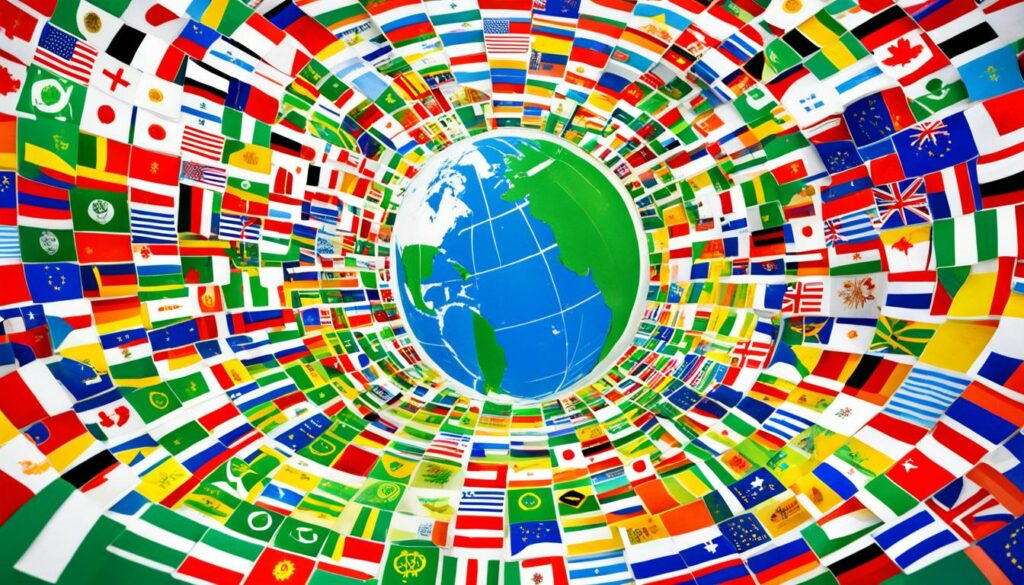
The Paris Agreement and the Sendai Framework are setting the pace for the world. They have big goals to fight pollution and save trees. Policymakers are putting strict rules and plans in place to meet these targets. They’re working hard to stop problems like too much pesticide and cutting down forests.
The World Bank is pushing for smart farming that helps the climate. They are calling these plans CSAPIPs. They help countries worldwide farm in a green way. The EU and others are leading by example with their strong environmental rules.
Rich countries generally have tougher rules. But some wealthy places, like Qatar and the UAE, have less farming rules. It’s important to understand these differences. Working towards farm rules that are good for everyone is key.
| Region | Policy Focus | Notable Impact |
|---|---|---|
| European Union | Climate Neutrality, Emissions Reduction | EU Climate Law, European Green Deal |
| United States | Fertilizer Usage, Emissions Reduction | High Fertilizer Use, Stringent Emission Policies |
| China | Pesticide Reduction, Fertilizer Subsidies | Zero-Growth Pesticide Policy, Subsidies for Farmers |
| Sub-Saharan Africa | Resource Management, Conservation | Less Intense Policies, Lower Fertilizer Use |
The future of sustainable farming laws is about to shift the agriculture industry. With over 40% of the world’s people in this field, its effect on our planet is huge. The need for ecological regulations for the agriculture industry is more vital than ever. This is because agriculture is a major source of the planet’s greenhouse gases.
Future rules are likely to support advanced green practices. Methods like permaculture, biodynamic farming, and agroforestry are key. They increase biodiversity and make life better for farm families and communities. Such approaches show that upcoming sustainable farming laws will focus on big-picture thinking and smart use of land.
Organic farming is another big future player. It’s more labour-intensive than regular farming, but it brings in more money. This underlines that future farming will also be about making a profit.
Wildlife farming, which is responsible for 18% of global greenhouse gases, will see tighter rules. These rules will manage livestock better and blend them with crop farming. Decreasing water use is also a priority, with agriculture using 69% of the world’s fresh water. New laws will push for smart water use, even in places with little water.
The National Institute of Food and Agriculture and the World Bank will keep supporting these changes. They will help farmers shift by explaining complex new rules. Adapting to the changing laws is key for farming’s future success and health of the planet.
Technological progress will profoundly affect farming. AI, biotechnology, drones, and blockchain will all make big differences. They will help farmers meet the new ecological rules and thrive.
To sum up, farmers are entering a new, vital phase with the advancing sustainable farming laws. They must welcome new methods and technologies. This is to both fulfill the law and to make sure farming stays profitable and earth-friendly for years to come.
The world needs global standards for how we farm the land. These rules help us farm in ways that are good for the earth everywhere. They make sure we grow food while also protecting the environment. NQA has given out over 50,000 certificates in 90 countries. This shows they know a lot about farming in different areas.

ISO standards are very important for farming. For example, ISO 9001 is about making sure farms run well. ISO 45001 keeps farmers and the people who buy their products safe. It does this by making sure there are good health and safety rules in place.
It’s crucial to use energy wisely on the farm. ISO 50001 helps farms get better at using energy. ISO 14001 cares about how farms affect the environment. It helps farms reduce their harm and follow the law.
Keeping food safe is also key. ISO 22000 makes sure food safety is managed well across the world. The FSSC 22000 standard focuses on keeping food safe during its making. For protecting information, ISO 27001 helps keep farm data safe from harm.
The LEAF Marque is another important stamp of approval. Over 770 farms have earned this around the world. It shows they are working hard to protect the environment. Getting the LEAF Marque means doing better every day at looking after the earth.
Bodies like NSF make sure farms meet these high standards. They check if farms meet the needs of Red Tractor, GLOBALG.A.P. IFA, and LEAF Marque. They help to make the rules stronger and keep them in good shape. The LEAF Marque also helps farms sell more and find new markets, especially in Europe.
| ISO Standard | Description | Relevance |
|---|---|---|
| ISO 9001 | Quality Management Systems | Ensures efficient agricultural operations |
| ISO 45001 | Occupational Health and Safety | Protects employees, customers, and the public |
| ISO 50001 | Energy Management | Optimises energy efficiency |
| ISO 14001 | Environmental Management Systems | Reduces environmental impact and legal issues |
| ISO 22000 | Food Safety Management | Ensures safety in global food chains |
| ISO 27001 | Information Security Management | Secures business data from threats |
Overall, using global standards in farming is key to our future. These rules help us farm in ways that are good for the earth and safe for us. They make sure farming is both safe for the environment and provides enough food worldwide.
Urban farming is gaining popularity and changing how we think about sustainable agriculture. It cuts down on the harm of transporting food over long distances. This way, it helps keep food supplies solid in our communities. As cities grow and farmland is hard to find, putting farms in city spaces has many benefits.
One major plus of urban farming is less pollution from moving food around. This is key because the up to 18.4% of global greenhouse gas emissions come from farming and forestry. Growing food near where it’s eaten helps lower the pollution from its distribution.
There’s also the smart use of resources to consider. Look at AeroFarms in Newark, which uses less land and water but grows more food than standard farms. The idea is to get more from smaller spaces, cutting down on waste and the farmsight needed, while still growing plenty of food.
Projects like AeroFarms show urban farming can really work well. By using high tech vertical farming, they provide fresh food locally. This means less waste and more food for the area using less land and water.
Community gardens and local farms are also big for making sure cities have enough to eat. They’ve been shown to make cities more able to bounce back from hard times. They make a strong case for growing food within our cities for a more secure and eco-friendly future.
The 2018 Farm Bill in the USA is a good example, pushing for more urban farming. It gives support to new ways of growing food and partners with groups like the Chicago Botanic Gardens. This kind of support is crucial for encouraging and growing urban farming sustainably and effectively.
| Project | Location | Productivity | Advantages |
|---|---|---|---|
| AeroFarms | Newark, New Jersey | 390x traditional fields | Local food security, reduced water usage |
| Chicago Botanic Gardens | Chicago, Illinois | Community engagement | Sustainable agriculture education |
| People’s Gardens | Nationwide | Various | Food security, urban greening |
The push for sustainable agriculture is commendable, yet it faces big hurdles. Farmers want to go green but face issues due to costs and tech challenges. These problems make meeting strict environmental rules hard.
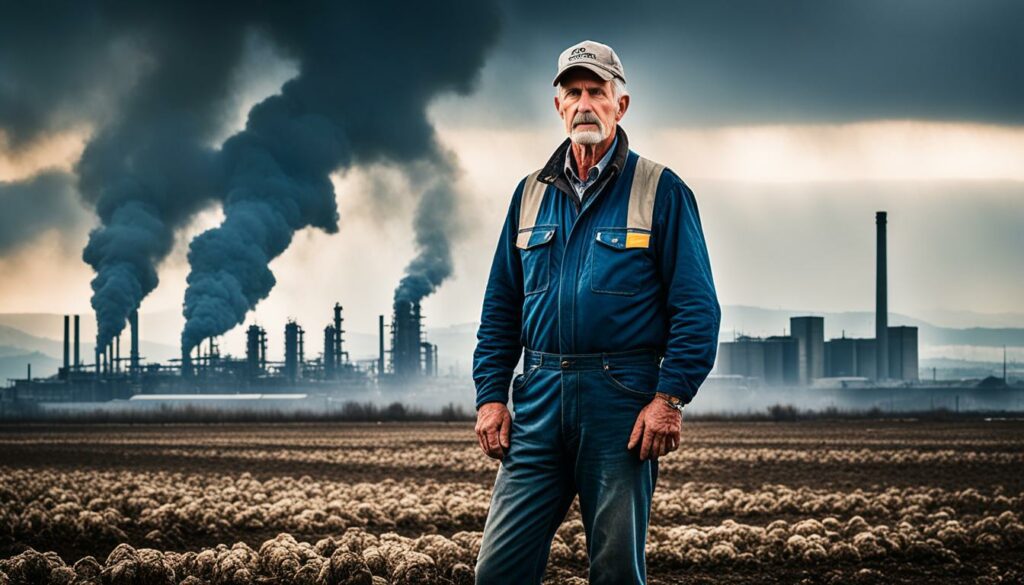
Funding is a major issue for farmers to follow new rules. They need money for new gear, eco-farming tech, and updated methods. In Europe, farmers have been protesting since December 2023 over subsidy cuts and new environmental rules.
In the United States, there’s also pressure on farmers. They’re asked to adopt eco-friendly practices for better water and soil and to cut down on air pollution. This includes investing in new farming methods.
Technology barriers pose a significant challenge. Farmers worry about keeping up with the technological demands. With the shift towards smart farming, there’s a lot to learn.
The EU’s Farm to Fork strategy aims to help, but it’s not easy for everyone. Some, like Bill Coogan, prefer the old ways. His son, Jarred, sees the need for change, especially in complying with new rules and using technology. These changes are creating stress in the farming community.
An example is the Coogan family, who saw more lamb production with better techniques. Increasing the use of modern farming strategies helped. But, farmers need help to adopt these new technologies.
To overcome challenges in sustainable agriculture, support is key. With help from the government and educational programs, farmers can better switch to green practices. This support would help solve many problems and make agriculture stronger.
Current global rules for farming are changing quickly. Farmers need to keep up with these rules for the environment. They focus on controlling emissions, using land better, and protecting farming resources.
Farmers must watch important rules, especially about emissions. Farming adds a lot to the greenhouse gases in Europe and elsewhere. Big companies, like Pepsi and Walmart, are helping farmers with millions of dollars. They want to improve the health of the soil and water.
Another key rule is about how land is used. Farmers are now using more eco-friendly methods. For example, they went from tilling the land a lot to tilling less, which helps prevent soil loss. This change shows how many are working to farm in ways that are kinder to the earth.
These rules change how farmers work every day. Many are using smart technology more. For example, 40% of corn fields used new tech in 2016. This technology helps use resources better and waste less.
Rules are also changing how water is used for crops. Many areas are now using sprinklers more than before. This uses water more wisely, which is good for the planet.
Farmers are also learning about new farming methods to be more eco-friendly. These methods don’t just follow the rules, they also make farms more sustainable.
Knowing about global farming rules is very important for today’s farmer. It helps them follow laws from all over the world. And it promotes farming that cares for the future.
People worldwide are learning more about the harm meat production does to our planet. This knowledge is making many consider switching to plant-based diets. Such a change not only helps the environment but also affects the agriculture market trends.
One key benefit of plant-based diets is using less land and reducing greenhouse gases. By eating less meat, we lower the amount of methane from farms. This gas is very harmful to our atmosphere.
Choosing plants over meat also means we don’t need as much land to farm. This helps keep natural areas safe for wildlife. It makes our use of land more sustainable for the planet as a whole.
Researchers are looking into how putting carbon footprint labels on food affects what we buy. It’s an important area of study. Knowing more could help encourage more people to pick foods that are better for the environment.

Companies that make plant-based foods are becoming more popular. This trend is making the agriculture industry consider new ways to grow food. Efforts are being made to make plant-based foods a bigger part of what we eat every day.
Even with these changes, some groups are not being heard. Men and ethnic minorities often don’t get included in food surveys. This means we don’t always have the full picture of what everyone is eating.
While some people are trying to eat less meat, it’s not always leading to buying more plant-based foods. Studies have shown this challenge in the UK. More research is needed to understand how to overcome this obstacle.
Learning how people see food and make choices is crucial for agriculture’s future. By paying attention to how social norms change, policymakers can help us move towards a more sustainable way of eating. They can develop strategies that really make a difference in promoting plant-based diets.
The move towards plant-based diets is a big deal for the agriculture market. It offers hope for a future where we can both eat well and look after the environment. Sharing positive stories about plant-based diets is important. It helps people feel good about choosing these foods.
The lab-grown meat industry and alternative meats seem to be the next big thing. They’re tackling the issue of how much land and resources livestock need. With places like Singapore giving the nod to lab-grown meats and more people choosing plant-based options, the food world is changing.
Yet, making lab-grown meat can be worse for the planet than getting beef from a store. The way we make it now can cause four to 25 times more global warming than the beef you find in shops. Even the most environmentally friendly beef farms do better than lab meat in this area.
If we make lab meat from ingredients found in food, it could be a better choice for the environment. It might cause up to 80% less warming than usual beef. But, giving more attention to making beef with the climate in mind could cut emissions faster than focusing on lab meat. This is important because the world is eating more meat, which makes the problem worse.
The good news is, making lab meat uses up way less land than what’s needed for farming animals. This helps save natural spaces. Less water is used too, making the whole process better for the planet.
Still, there are big challenges for lab-grown meat, like making enough and being affordable. Despite this, things are getting better with more research and new technology. The future for alternative meats seems bright, even with these hurdles.
Mitigating greenhouse gas emissions in agriculture is key for global climate goals. To achieve this, we must use effective methane strategies and new technologies. These steps can lower the impact of farming on the environment without harming productivity.
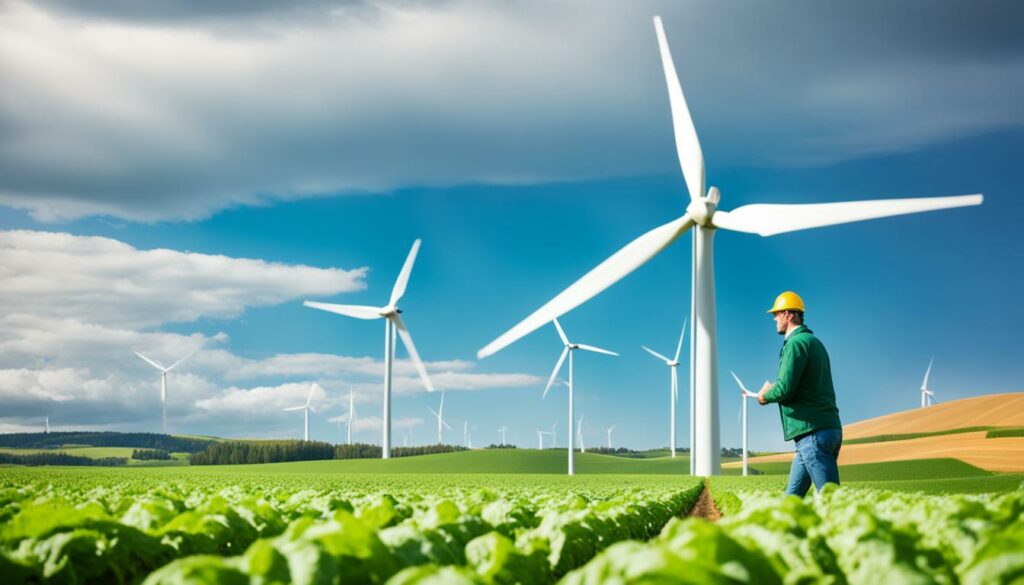
Livestock and dairy farms are big sources of agricultural greenhouse gases. They can reduce methane by changing what animals eat and using bio-digesters. Also, better handling of manure can cut down on emissions.
Precision farming is critical in dropping greenhouse gas emissions. Techniques like plant testing and careful use of nutrients can lower the need for nitrogen fertilisers. Using less invasive farming methods helps keep soil healthy and cuts emissions too.
The cap-and-trade system gives farmers credits for reducing emissions. Programs like the Renewable Fuel Standard also help by promoting biofuels, indirectly cutting down greenhouse gases. Teaching farmers new methods and knowledge is essential in reaching these emission-reduction goals.
Stopping deforestation is key to saving natural habitats and the world’s ecological balance. There has been a big increase in policies to tackle this, especially in the 2000s and 2010s. These actions help support farming that looks after the land, which is more common in wealthier nations.
In the European Union, for instance, there are over 90 such rules for each country. But in Africa, there’s usually less than 20. This shows that wealthier places have more ability to put strong deforestation laws into action. For example, Europe and the US use about five times more fertiliser on their farms than the average farm in Africa.
China, meanwhile, is cutting down on its fertiliser use. They’re doing this by helping farmers to use their fertilisers smarter, as well as giving them supports. This has helped keep farms productive while lowering the harm to the environment. In 2015, China brought in a rule to stop growing the use of pesticides. This measure made a big difference by reducing how much pesticide was being used a lot.
Yet, we must think about all the effects of these policies. Even though they cut down on pollution and stop the land from eroding, some of these rules might not always be perfect. They could sometimes lead to less food being grown or affect food around the world. But since cutting down trees adds a lot to the world’s climate changing gases, it’s really important to try and solve these problems well.
A big review led by Stern shows that stopping deforestation is really cost-effective in fighting the climate crisis. The Bali Action Plan backs this up. It talks about using policies and rewards to keep forests from being cut down. It’s important to see that turning forests into something else is a special problem. We can learn about this from the Global Forest Resources Assessment, which looks at how land gets changed. Market mistakes, poor policies, poverty, and wrong choices sometimes cause deforestation. Different groups, like people just getting by, big companies, the government, and others, can all help make this problem worse. And they are often pushed by different economic and social reasons.
Water is a key resource for farming, but it’s becoming scarce worldwide. To tackle this, farmers need to use water wisely and avoid waste. The use of water in agriculture is huge, exceeding 90% in some U.S. states alone. Nearly half of the world’s people might face ‘severe water stress’ by 2030. So, it’s vital to look at ways to use water better and reduce waste.
In the face of a 40% water shortfall by 2030, modern farming needs smart solutions. Technologies like smart water sensors are changing the game. Drip irrigation, for example, uses less water and keeps plants healthier. Uses like capturing and reusing water also play a big role in saving this precious resource.
To cut down on water waste, farmers can do a lot. They can use smart irrigation and care for the soil better. Techniques such as composting and mulching help keep water in the soil. Cover crops and not tilling too much can stop water from running off. Plus, rotating crops can make better use of water and keep the soil healthy.
| Technique | Benefits |
|---|---|
| Drip Irrigation | Reduces water wastage, promotes better plant health |
| Smart Water Sensors | Optimizes water use, ensures efficient irrigation |
| Composting and Mulching | Reduces evaporation, improves water retention |
| Cover Crops | Enhances water infiltration, reduces surface runoff |
| Conservation Tillage | Preserves soil structure, reduces erosion |
| Crop Rotation | Optimizes water use, replenishes soil moisture |
| Water-Conserving Crops | Improves water efficiency, copes with water limitations |
China is showing great progress in sustainable farming. At a workshop organised by IIED and CAU, 30 people shared case studies. These studies show how farming can be both productive and kind to the environment.
In China, eight different projects focus on eco-friendly farming. For example, Shared Harvest in Beijing has 460 people supporting it. In Jiangxi Province, 17,000 families are doing organic farming. This shows a big move towards greener farming methods.
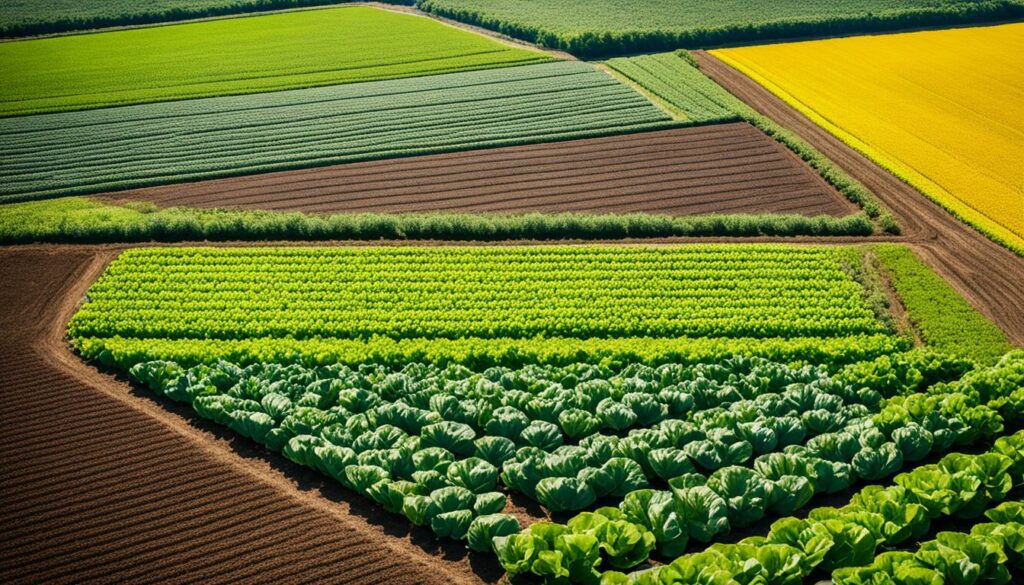
Around the world, many are adopting sustainable farming techniques. Denmark combines animals and crops and returns crops to the earth. In Spain, trees are planted with crops to protect the soil and save water. These are great steps towards caring for the earth as we farm.
In different parts of the world, we see unique ways of farming sustainably. The table below covers some of the main achievements:
| Country | Sustainable Practice | Impact |
|---|---|---|
| China | Community Supported Agriculture (Shared Harvest) | Enhanced community involvement and local food security |
| Denmark | Integration of livestock and crop production | Increased soil fertility and reduced waste |
| Spain | Agroforestry | Reduced soil erosion and optimised water use |
| California | Precision farming | Efficient input application and waste reduction |
| Brazil | Agroecology | Fostered biodiversity and conservation efforts |
Sustainable farming case studies are teaching us a lot. They show us how to farm that’s good for the earth and produces food. Learning from these examples helps us find the right balance between farming’s needs and protecting the planet.
Support and resources are vital as farmers adapt to new environmental rules. Government funding and education are key. They help lessen the costs and ensure farmers have the skills needed for a sustainable future.
Government aid is a big help for sustainable farming. Departments like Rural Development offer financial help. They support projects improving internet, homes, and farm infrastructure. Loans and grants assist rural families and businesses, making it easier to adopt new farming methods.
| Agency | Focus |
|---|---|
| Food Safety and Inspection Service (FSIS) | Ensuring meat, poultry, and egg product safety under various acts |
| Marketing and Regulatory Programs (MRP) | Regulating genetically engineered organisms and setting agricultural standards |
| Trade and Foreign Agricultural Affairs (TFAA) | Promoting U.S. agricultural exports through market intelligence and trade policy |
Programmes and training are vital for green farming. They make the U.S. food and fibre system stronger and more environmental. Training ensures farmers use sustainable methods. This includes the protection of national resources, like forests and grasslands.
Cooperation with groups like the Department of Food, Nutrition, and Consumer Services is key. It improves food access and nutrition by sharing science-based advice. International efforts in places like Ecuador and India fight pollution. They highlight the worldwide push for sustainable farming.
Looking back, the journey to sustainable farming shows it’s not simple. But we know we need many solutions to farm and care for the environment. In 2007, farming and forestry in the US added a lot to the planet’s heat-trapping gases. We fight this by capturing carbon, like leaving more plant leftovers on fields and not tilling as much.
Using tech helps too. It lets farmers be very precise, using only what’s needed to grow crops. This boosts how much they can farm while cutting down harmful emissions. For animals, new types of food and even machines called digesters can lower the gas they produce.
Big policies that push for clean energy from farms are key for the future. They encourage making fuels that don’t hurt the climate, pushing everyone to reach net-zero emissions by 2050. This is a top goal, as shown by plans in Europe.
For real progress, the world must work together. Countries and local areas should support farmers by paying them more for doing good things for the planet. This not only helps farmers financially but also makes sure they follow new rules. This way, sustainable farming isn’t just an idea but something all farmers can really do.
Farmers must watch out for rules on emissions, land use, and saving nature. These rules guide everything, from using resources to growing crops. They are key for farming that lasts.
Farmers need to know the latest in global green rules as they shape farming’s future. These rules affect how farmers get help, use resources, and trade around the world.
CSA is a big plan to make farming fight climate change and keep food coming. It mixes growing more food, changing to better practices, and using tech wisely.
Precision farming makes farming green by using what each plant needs. This cuts waste and makes farms better for our planet. It matches changing farming rules too.
Look at Phytech and Syngenta working together. They use smart tech for watering and feeding plants. This helps make more food without hurting nature.
Worldwide green rules set the bar for good farming. They’re about cutting pollution and using land better. They push for following big groups like the World Bank’s advice.
Green farming laws are set to get tougher on pollution, land use, and saving water. Farmers will have to change to keep up and make money.
Local and city farming cuts pollution and makes food closer to people. Places like AeroFarms show how to grow a lot in small spots. They’re good examples for green farming.
Farmers meet money hurdles in keeping to new rules, getting new gear, and learning new ways. Tech barriers are about understanding and using new tools well.
Eating more plants helps fight climate change and uses less land. It’s making farmers rethink how they farm. Beyond Meat shows there’s a demand for these foods.
Lab and alternative meats use less land, easing the pressure from farming animals. Getting the okay in places like Singapore is a big step forward for green food.
Farmers look into special feeds and smart farming tech to cut climate gases. This way, they can farm and help the planet at the same time.
Rules about cutting forests and using land are key for keeping farming and nature in balance. Using land right helps worlds farm and stay green.
Farming needs water management because water’s running out. High-tech watering helps farm make more food while saving water. It shows farming cares for the Earth.
Good farm examples help others know what works in nature and makes money. They show farming can be kind to the Earth and still be a success.
Farmers get help through cash aid and learning programs. This helps them handle the cost and know how to farm green.